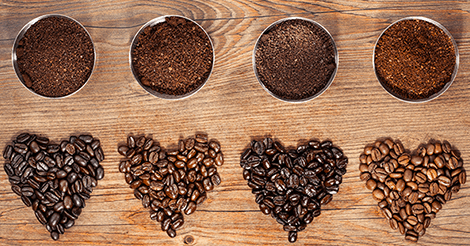Coffee Varieties: 4 Roasts You MUST Know
 Take a second and ask yourself what “coffee” has in common with:
Take a second and ask yourself what “coffee” has in common with:
- Beer
- Wine
- Cheese
Time’s up! They’re all common nouns describing many variants.
Think about it.
The words “beer,” “wine,” and “cheese,” represent classes of highly unique variations. Each of these names represents collections of variants highlighting specific characteristics and attributes enthusiasts recognize.
The same applies to coffee! A spectrum of unique flavors, aromas, and acidity characterize particular “roasts” of coffee. Some experts claim individual roasts present varying caffeine levels as well.
So, what are the different categories of “coffee?”
It All Starts With Roasting!
The coffee roasting process transforms green, earthy beans into the dark, aromatic product used in the brewing process. Roasted beans fall into four main types:
- Light
- Medium
- Medium Dark
- Dark
These names refer to the color of the bean at the end. Each roast possesses specific characteristics used to brew specific types of coffee. But what are the fundamental differences?
Light Roast Coffee
Beans roasted between 180°C and 205°C produce light bodied coffee. Light roast coffee includes coffee beans roasted up to the “first crack.” The first crack occurs at about 205°C when the beans split open and expand.
Roasted coffee beans present a characteristic of toasted grain in general. Lighter roasts taste noticeably acidic and preserve the most flavor from the bean. Specific factors, like the climate and elevation of the plant, introduce unique qualities because this roast retains so much of the original character.
Common Light Roast Coffee Varieties:
- Light City
- Half City
- Cinnamon
- New England
Medium Roast Coffee
Beans roasted between 210°C and 220°C produce medium bodied coffee. With less of the toasted grain attribute noticeable in lighter roasts, medium roasts present a more balanced flavor, aroma, and acidic profile.
Common Medium Roast Coffee Varieties:
- City
- America
- Breakfast
- Regular
Medium Dark Roast Coffee
Beans roasted between 225°C and 230°C produce coffee with a heavy body. At about 230°C, beans endure the “second crack” and pop open again. This level of roasting begins to pull oils from within the beans to the surface, giving them a dark sheen characteristic of darker roasts. This variety introduces flavors and aromas unique to the roasting process, and a “spicy” quality becomes present.
Common Medium Dark Roast Coffee Varieties:
- Full City
Dark Roast Coffee
Beans roasted between 240°C and beyond produce coffee with a bold, robust taste. The flavor showcases the potency of dark roasted coffee beans with bitter, smoked characteristics. This option also provides the most subtle acidic profile of all these variants. Dark roast beans display the most distinguishable sheen due to the large quantity of oil drawn to the surface.
Common Dark Roast Coffee Varieties:
- European/Italian/Viennese/French
- Espresso
- Continental
- High
- New Orleans
Roast Review
Raw coffee beans undergo a process, known as roasting, to refine specific flavors, aroma, and acidity. Lightly roasted beans present natural, earthy flavors. As the temperature increases, darker roasts alter the balance of organic accents into more robust and bitter characteristics.
Each roast presents a taste and bouquet different from the rest. Knowing these differences provides the basic understanding necessary when to hunting for the perfect cup of coffee.
Are you looking for a quality office coffee service? Our Java Geniuses are ready to bring quality office coffee delivery to your business, workplace or shop. Contact our team or call us at 866-452-8228

 Order Online
Order Online